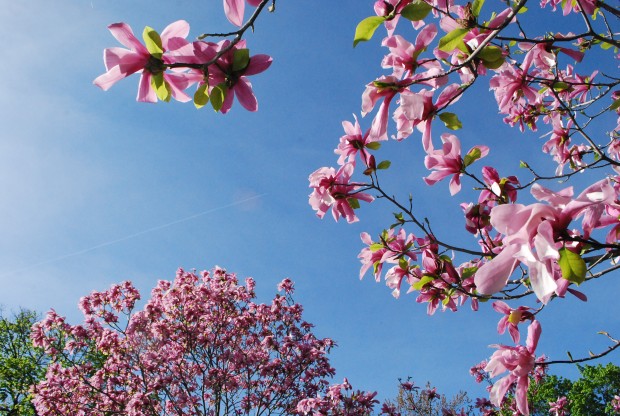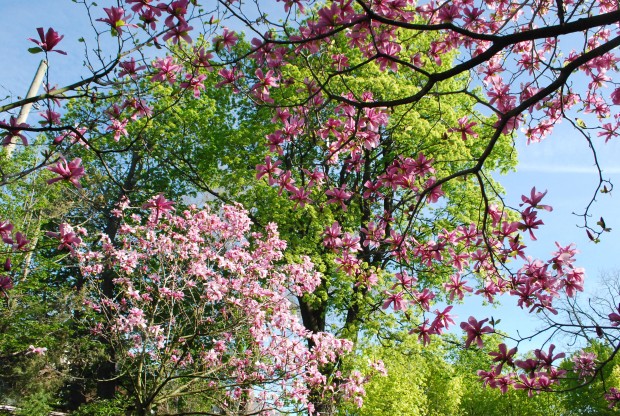 In most every year I have written this blog, there is an essay about magnolias. I have a big love for them. The flowers are dramatic and showy-I so welcome a gesture of this magnitude after a long winter. A good bloom is never a certainty. They bloom early in my spring-which also means they bloom late in my winter. Last year, given a string of April days in the low twenties, every bud was reduced to a gooey black rotted mess, hanging from the branches. That hanging persisted well into the summer-a vile reminder of the capricious nature of spring weather.
In most every year I have written this blog, there is an essay about magnolias. I have a big love for them. The flowers are dramatic and showy-I so welcome a gesture of this magnitude after a long winter. A good bloom is never a certainty. They bloom early in my spring-which also means they bloom late in my winter. Last year, given a string of April days in the low twenties, every bud was reduced to a gooey black rotted mess, hanging from the branches. That hanging persisted well into the summer-a vile reminder of the capricious nature of spring weather.
 But when the magnolias are good, they are very very good. My neighborhood has plenty of old saucer magnolias in evidence. Some are planted very close to the foundations of homes-they do not seem to mind this. Many have multiple trunks that have grown to considerable size. A saucer magnolia in full bloom is heart stoppingly beautiful. My saucer magnolias are a hybrid of magnolia soulangiana, named Galaxy. The day I planted the three of them in my driveway garden, they had long spindly arms-gawky, they were. The one tree with the most sun has grown to a considerable size.
But when the magnolias are good, they are very very good. My neighborhood has plenty of old saucer magnolias in evidence. Some are planted very close to the foundations of homes-they do not seem to mind this. Many have multiple trunks that have grown to considerable size. A saucer magnolia in full bloom is heart stoppingly beautiful. My saucer magnolias are a hybrid of magnolia soulangiana, named Galaxy. The day I planted the three of them in my driveway garden, they had long spindly arms-gawky, they were. The one tree with the most sun has grown to a considerable size.
 The second tree will catch up to tree number one in the next few years. Tree 3 took a giant hit in the trunk from a careless truck driver in the driveway. Late this winter I took down an old Norway maple in this area whose girdling roots have been hard at work squeezing the life out of it. So little of the canopy was green last year-looking at it made me wince. It was time to give up the maple, in the interest of the health of the magnolias-and a group of parrotias.
The second tree will catch up to tree number one in the next few years. Tree 3 took a giant hit in the trunk from a careless truck driver in the driveway. Late this winter I took down an old Norway maple in this area whose girdling roots have been hard at work squeezing the life out of it. So little of the canopy was green last year-looking at it made me wince. It was time to give up the maple, in the interest of the health of the magnolias-and a group of parrotias.
 This cool spring made for a glorious magnolia bloom season. I admired them up close. I stood under their blossom laden branches. I admired them from afar. Why this love of magnolias? The spectacular bloom aside, they are a very handsome tree. The grey bark is beautiful. The mossed bark on old trees-sensational. The leaves are large, and glossy. Their winter shape is strikingly architectural. They are beautiful trees, no matter the season. Their mature size is a size that any modest city property such as my own, could accommodate. I have a city lot and a half, which is home to 11 magnolias-no kidding.
This cool spring made for a glorious magnolia bloom season. I admired them up close. I stood under their blossom laden branches. I admired them from afar. Why this love of magnolias? The spectacular bloom aside, they are a very handsome tree. The grey bark is beautiful. The mossed bark on old trees-sensational. The leaves are large, and glossy. Their winter shape is strikingly architectural. They are beautiful trees, no matter the season. Their mature size is a size that any modest city property such as my own, could accommodate. I have a city lot and a half, which is home to 11 magnolias-no kidding. 
8 of my magnolias are planted in the half lot, in the front of my yard. They are under planted with boxwood. They are yellow magnolias-yes yellow. Hybridized by Phil Savage, the blooms of the magnolia “Butterflies” are the most astonishingly gorgeous pale yellow imaginable. I met Phil Savage when I was young, and working for Al Goldner. Al was a landscape designer who owned a nursery. He loved plants-and he loved design. I was so lucky for my exposure to him, and his work. Al made it his business to introduce anyone designing for him to people who grew great plants. So many years later, I treasure that experience.
 Phil owned a large property in my area. Though he passed away a few years ago, that property is loaded with magnolias-many of which exceed 60 feet in height. I had occasion to see his trees in full bloom a few years ago, courtesy of a niece, who is a client. I was astonished at what I saw. Yellow, peach, pale pink and hot pink flowers on magnolias that towered high above the ground. My pictures of his property are so bad-I would not publish them. But the experience of his vision about magnolias-this I will never forget. This is why I plant magnolias, any time I have the chance.
Phil owned a large property in my area. Though he passed away a few years ago, that property is loaded with magnolias-many of which exceed 60 feet in height. I had occasion to see his trees in full bloom a few years ago, courtesy of a niece, who is a client. I was astonished at what I saw. Yellow, peach, pale pink and hot pink flowers on magnolias that towered high above the ground. My pictures of his property are so bad-I would not publish them. But the experience of his vision about magnolias-this I will never forget. This is why I plant magnolias, any time I have the chance.
The bloom, even in a really great year, is not long. Should you need more than that momentary experience of their shockingly beautiful flowers, consider their leaves, and their gorgeous shape. I for one do not mind an experience of the garden that is fleeting. Every season has its perfect moment. I do not need any plant, any garden, or any landscape to to do more than their season. I do not hold the brevity of a season against any tree. As for Phil Savage’s property-yes. It has been sold. The buyer I would guess has no interest in that magnolia forest the likes of which I am sure does not exist any where else on this planet. The new owner has another idea in mind. I hear from friends and colleagues in the growing community that there is a plan to take cuttings. I so pray this plan comes to be.
A plan to preserve and nurture the magnolias bred by Phil Savage-this seems a fitting essay for Mother’s Day weekend.









